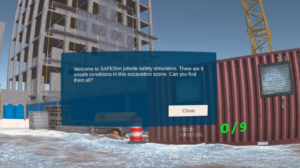Innovating for the Future of Construction
September 18, 2020
Brasfield & Gorrie is piloting new technologies that use augmented and virtual reality to advance our efforts. With innovation as one of our core values, we build on more than 56 years of construction experience to continue exploring new ways to improve processes for the sake of safety, efficiency, and quality. Brasfield & Gorrie’s Virtual Design + Construction, Innovation, and Operational Technology teams have several AR/VR projects in development that we anticipate moving from testing to regular use in the coming year.
Building on an Existing Foundation
For several years, we’ve used virtual reality to improve design and construction. Virtual mockups revolutionize walk-throughs because they allow clients to see design changes immediately. We use them most often for mocking up hospital patient rooms and operating rooms. Mechanical, engineering, and plumbing coordination can also use VR technology to identify issues, communicate tasks, and easily visualize the design. We’re building on these successful uses of VR that are already common on our projects.
Augmented Reality in Presentations
A picture may be worth a thousand words, but augmented reality can increase that image’s value. By using augmented reality, we’re able to enhance site logistic plans so our presentations offer potential clients a greater understanding of what a project will entail.
Safety Simulation Video Game

Our team developed a virtual reality jobsite safety training that uses the Oculus Quest to immerse users in a fully navigable 3D environment. The first level is a typical excavation scene with eight hazards the player must identify using a virtual laser pointer. We will expand the game to include more levels with additional construction scenarios, such as elevated slab pours and confined spaces. The virtual reality experience allows employees to apply their safety training in a simulated environment, offering them practice identifying hazards before they step onto a jobsite.
Microsoft HoloLens and Remote Assistance

We are testing the Microsoft HoloLens on several projects, where it helps make models more accessible to teams in the field. The HoloLens helps team members overlay our coordination model onto the jobsite to visualize systems that have yet to be installed and to track the progress of those that have been. On a healthcare project, for example, this technology helped the field team realize we were missing a pneumatic tube opening in the slab. We were able to correct this before it became an issue for the installation team.
We’re also testing Microsoft Remote Assist with HoloLens on jobsite walks to keep architects, engineers, and owners connected by bringing them along virtually. These stakeholders see what the person wearing the HoloLens sees. They’re able to make notes, send documents, and discuss any issues they spot in real time. This is improving communication, and we anticipate it leading to faster conflict resolution by allowing teams to see information in context.
Trimble SiteVision

Before our project teams self-perform a concrete pour, they walk the site to review placement of items that will be embedded in the concrete. Performing quality control in this way is tedious and time-consuming. We are testing Trimble SiteVision, a handheld AR device that uses GPS technology and 3D models or shop drawings to expedite the review process. This technology would allow team members to verify embed quantity and placement accuracy, improving the efficiency of embed quality control.
Our innovation specialists are constantly assessing emerging technology and how it may improve the construction process for all our projects. As we fine tune these use cases, we look forward to wider implementation of these technologies.